| Pages:
1
..
6
7
8
9
10 |
Brominated Potato
Harmless

Posts: 1
Registered: 18-8-2016
Member Is Offline
Mood: No Mood
|
|
About graphitization, I found this article about graphitization of charcoal using rare earth metals:
http://pubs.acs.org/doi/abs/10.1021/acs.langmuir.6b02000
The abstract seems relevant but I can't afford 40 dollars.
|
|
|
NEMO-Chemistry
International Hazard
    
Posts: 1559
Registered: 29-5-2016
Location: UK
Member Is Offline
Mood: No Mood
|
|
save your money and enjoy
although i think your are supposed to ask in references, so grab quick incase the file has to be removed. Ask a admin for access to ref i will plonk
a copy there incase
Attachment: wang2016.pdf (6.1MB)
This file has been downloaded 571 times
|
|
|
aga
Forum Drunkard
    
Posts: 7030
Registered: 25-3-2014
Member Is Offline
|
|
Beaten-up carbon, no matter what the starting compounds were, nor the process, is likely to become an entire field of physics/chemistry in itself.
chironex's exploits got me interested in the whole Carbon Quantum Dot thing (CQD/QD/CD).
Zhi et al came across QDs while trying to purify them.
Turns out that many abused carbon materials contain them.
Anyone ever seen some brown/black tarry goo after an OC experiment ?
Guess what's in there.
Sticking stuff in a microwave seems to be the easiest route to QDs, so i'll give that a try, seeing as the results have already been documented.
Attachment: yang2013.pdf (395kB)
This file has been downloaded 551 times
|
|
|
mayko
International Hazard
    
Posts: 1218
Registered: 17-1-2013
Location: Carrboro, NC
Member Is Offline
Mood: anomalous (Euclid class)
|
|
Another Brominated Potato request
Attachment: Iron-catalyzed graphitization of biomass.pdf (2.3MB)
This file has been downloaded 517 times
al-khemie is not a terrorist organization
"Chemicals, chemicals... I need chemicals!" - George Hayduke
"Wubbalubba dub-dub!" - Rick Sanchez
|
|
|
MrHomeScientist
International Hazard
    
Posts: 1806
Registered: 24-10-2010
Location: Flerovium
Member Is Offline
Mood: No Mood
|
|
It was a rainy day off work today so I thought I'd give this a shot. I bought a quart-size metal paint can and punched two holes in the lid for gas
exhaust. I loaded this with 3 slices of honey wheat bread.
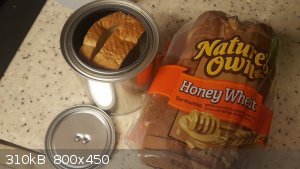
This was placed in my charcoal chimney "furnace" and heated for about 50 minutes. About 20 minutes in, the smoke coming from the holes in the lid
caught fire and burned for a while, as was noticed by others.
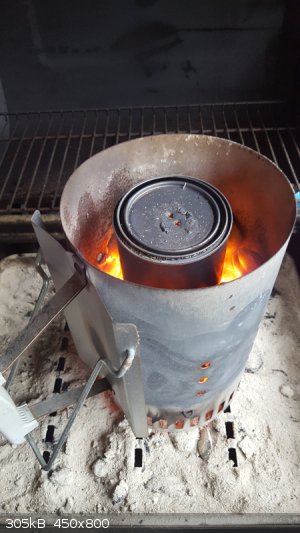
After cooling down here's what it looked like. The bread had shrunk considerably and is somewhat brittle, but I did get one nice tiny slice intact.
Neat!
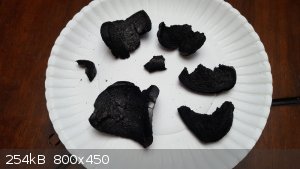
I made good use of the coals afterward.

|
|
|
aga
Forum Drunkard
    
Posts: 7030
Registered: 25-3-2014
Member Is Offline
|
|
Awesome !
Measure the resistance of the product - obviously not the sausages.
|
|
|
MrHomeScientist
International Hazard
    
Posts: 1806
Registered: 24-10-2010
Location: Flerovium
Member Is Offline
Mood: No Mood
|
|
Stabbing the bread with probes 1cm apart, I got several readings. The average for the large piece (pictured) was about 15 ohms. The other pieces had
values around 80, 30, and even just 8 ohms.
80 ohms over 1cm corresponds to 0.8 ohm*m, and looking up a table of resistivities of various materials (here) that's about 300x less conductive than graphite measured along the plane of the sheets. The 8 ohm measurement would then be 30x less
conductive. Assuming I have my facts straight.
I made somewhat conductive bread!
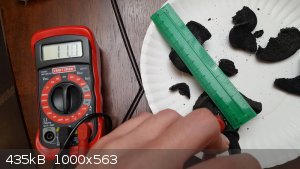
|
|
|
elementcollector1
International Hazard
    
Posts: 2684
Registered: 28-12-2011
Location: The Known Universe
Member Is Offline
Mood: Molten
|
|
Perhaps you should be looking at it another way: Given a resistivity of 3.5 x 10-5 ohm*m for amorphous carbon, your bread is approximately
23,000 times more conductive than regular ol' burnt bread.
Elements Collected:52/87
Latest Acquired: Cl
Next in Line: Nd
|
|
|
aga
Forum Drunkard
    
Posts: 7030
Registered: 25-3-2014
Member Is Offline
|
|
Excellent stuff MrHomeScientist !
The confirmation that it is also measurably conductive with a meter is very encouraging.
Has anyone tried burning some bread in air to see what resistance that ends up with ?
|
|
|
violet sin
International Hazard
    
Posts: 1480
Registered: 2-9-2012
Location: Daydreaming of uraninite...
Member Is Offline
Mood: Good
|
|
I've been really wanting to get back into this... But the time has been imaginary thus far. Ever since my better half handed me a solid black lump of
a potato found in back of oven, it's been on my mind.
Dollar store had bags of prilled Styrofoam. Basically just not stuck to one another, sold as decorative snow. I imagined making several potatoes
into mash and mixing in the wee Styrofoam orbs. If done right with super low temperature start and ramped up final temp, it could make great
insulation. Though I bet weak unless stabilized, chopped up fiberglass insulation? Hopefully that will be my next test. Need a good container for
this one, going to check the thrift stores when I get a chance.
|
|
|
Radium212
Hazard to Self
 
Posts: 85
Registered: 26-6-2017
Member Is Offline
Mood: Pyrophoric.
|
|
That really is quite amazing.
|
|
|
aga
Forum Drunkard
    
Posts: 7030
Registered: 25-3-2014
Member Is Offline
|
|
Today i baked a loaf and pyrolysed the resulting bread.
My half-baked (pun intended) idea was to add 10% sulphur powder to the mix, right at the start, in some vague hope that the yeast might utilise it
somehow and cross-link the gluten bits.
All it made was a smelly yellow loaf and a fairly nasty pyrolysis smell.
The end result is no non-conductive that it is effectively an insulator 
|
|
|
NEMO-Chemistry
International Hazard
    
Posts: 1559
Registered: 29-5-2016
Location: UK
Member Is Offline
Mood: No Mood
|
|
Dunno if this is any help.
Salicylic Acid and 4-Nitroaniline Removal from Water Using Magnetic Biochar: An Environmental and Analytical Experiment for the Undergraduate
Laboratory
DOI: 10.1021/acs.jchemed.6b00154 J.
I wanted the paper for something else, but i figure if its magnetic then it might help with the conductivity of Bio Char. I also think there is a copy
of the supporting material in refs.
|
|
|
aga
Forum Drunkard
    
Posts: 7030
Registered: 25-3-2014
Member Is Offline
|
|
The reason for adding Sulphur to the bread is all down to a nagging suspicion about Bread itself.
Our species evolved without 'manna', IF we are the species we think we are.
Currently i think it likely that we are derivatives of ancient aliens not that it makes any great difference in the scheme of things.
Probably a cross-breed kinda thing.
Now, going back into antiquity, some tens of thousands of years, we suddenly see what we assume are Humans abandon hunter-gatherer techniques (which
worked fine for millenia) and begin to Farm Barley, domesticate animals and build Cities - all in a very short time.
Looks more like meddling to me than 'natural' progression.
Anyway, that's Sumeria.
A bit of research found that Sulphur is available in large deposits in the zone once known as Akkadia, which appears to have had a close relationship
with Sumeria.
A place currently called Mishraq in Iraq has some sulphur deopsits, as do other places in Iran, so it was locally available back in Sumerian times.
Fundamentally it is a HUGE shift for a hunter-gatherer to begin to predominantly Farm instead of hunting/gathering.
To create Bread is also a HUGE leap. 2 step-changes so fast is supicious, hence suspecting that sulphur and bread were related.
Edit:
Also that some people say the 'Annuki' got humans to mine Gold, which is also yellow.
[Edited on 2-1-2018 by aga]
|
|
|
DrP
National Hazard
   
Posts: 625
Registered: 28-9-2005
Member Is Offline
Mood: exothermic
|
|
Quote: Originally posted by aga  | My half-baked (pun intended) idea was to add 10% sulphur powder to the mix, right at the start, in some vague hope that the yeast might utilise it
somehow and cross-link the gluten bits.
|
For better crosslinking in your char try Ammonium PolyPhosphate rather than sulphur. Preferably a fine powdered phase II grade. It is the industry
standard charring aid and cross linker.
\"It\'s a man\'s obligation to stick his boneration in a women\'s separation; this sort of penetration will increase the population of the younger
generation\" - Eric Cartman
|
|
|
MrHomeScientist
International Hazard
    
Posts: 1806
Registered: 24-10-2010
Location: Flerovium
Member Is Offline
Mood: No Mood
|
|
Stumbled across this the other day: https://www.youtube.com/watch?v=Wex_yKfrTo4
He makes his bread in a welded steel chamber filled with argon, and shows how resistant it is to heat by melting aluminum on it with a thermocouple
underneath. Neat!
|
|
|
aga
Forum Drunkard
    
Posts: 7030
Registered: 25-3-2014
Member Is Offline
|
|
It was stumble-able right back on page 1 of this thread.
|
|
|
MrHomeScientist
International Hazard
    
Posts: 1806
Registered: 24-10-2010
Location: Flerovium
Member Is Offline
Mood: No Mood
|
|
Damn! I should have practiced what I preach and read the thread.
|
|
|
aga
Forum Drunkard
    
Posts: 7030
Registered: 25-3-2014
Member Is Offline
|
|
It happens.
There is a rumour that even i posted without reading the thread (blush).
At least you didn't start a new thread based on a post in an existing thread, which leads to my next post ...
|
|
|
aga
Forum Drunkard
    
Posts: 7030
Registered: 25-3-2014
Member Is Offline
|
|
An attempt today using just a wood fire and aluminium foil didn't turn out too well.
Looks like i made a high-temperature dog poo.
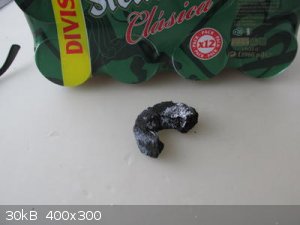
|
|
|
Chemetix
Hazard to Others
  
Posts: 375
Registered: 23-9-2016
Location: Oztrayleeyah
Member Is Offline
Mood: Wavering between lucidity and madness
|
|
I don't have the time to go and try this so don't crucify me. But has anyone tried, or would like to try, dipping their bread refractory foam in a
thin mix of plaster and see what happens. Or sodium silicate perhaps, just something to shield the carbon from getting oxidised.
|
|
|
aga
Forum Drunkard
    
Posts: 7030
Registered: 25-3-2014
Member Is Offline
|
|
Dipping a chunk of bread in some plaster slip would be very easy to do.
Nice idea Chemetix.
I tried a tin can today with very little Al foil as a cover.
Stupid really - the teeny amount of foil disintegrated.
Should just have turned the can upside down and used the floor as the seal. maybe with a brick on top to hold it down.
[Edited on 18-2-2018 by aga]
|
|
|
elementcollector1
International Hazard
    
Posts: 2684
Registered: 28-12-2011
Location: The Known Universe
Member Is Offline
Mood: Molten
|
|
Quote: Originally posted by Chemetix  | | I don't have the time to go and try this so don't crucify me. But has anyone tried, or would like to try, dipping their bread refractory foam in a
thin mix of plaster and see what happens. Or sodium silicate perhaps, just something to shield the carbon from getting oxidised.
|
I'm eventually hoping to get up to 2000 C thermal resistance, meaning that even plaster would melt at those temperatures, but hopefully graphite
and/or amorphous carbon would stand up. Also, store-bought plaster of Paris is incredibly prone to cracking unless you stabilize it with a fairly
precise mix of either cement and sand, or perlite and other stuff.
Dipping the bread, though, is probably a good idea. I've never worked with sodium silicate before, nor can I think of any liquid-coating solutions at
the moment, but what if one were to 'squeeze' bread between two lubricated steel containers, one larger than the other, and create a roughly-container
shaped piece of shielded bread that can then be charred?
I've also been wondering whether it's worth trying to make one's own bread for use in this experiment, instead of relying on store-bought versions.
Pizza dough comes to mind as a very formable, smooth-walled version, and it can be made pretty easily. Form it around a metal, cup-shaped object and
make your own 'graphite' crucible, maybe?
Elements Collected:52/87
Latest Acquired: Cl
Next in Line: Nd
|
|
|
aga
Forum Drunkard
    
Posts: 7030
Registered: 25-3-2014
Member Is Offline
|
|
I made my own bread for the last few attempts.
Making bread is really easy.
|
|
|
happyfooddance
National Hazard
   
Posts: 530
Registered: 9-11-2017
Location: Los Angeles, Ca.
Member Is Offline
Mood: No Mood
|
|
I feel like this is the only way to go, and be scientific, with this project. Most breads have a lot of salt, which I can only imagine would mess with
conductive properties, especially with adsorbed moisture.
|
|
|
| Pages:
1
..
6
7
8
9
10 |